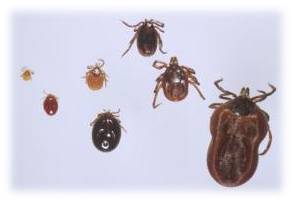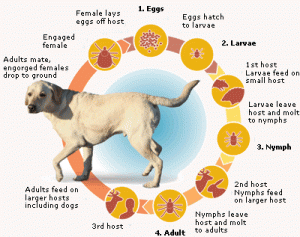What are ticks?
Ticks are small, blood-sucking arthropods related to spiders, mites and scorpions. There are many different species of tick in Britain and each species prefers to feed on different animal hosts. Given the opportunity, some of them will also feed on human blood.

Ticks have four distinct life stages that last from 2 months to more than 2 years, depending on the species:
- Egg: Females deposit from 3,000 to 6,000 eggs on the ground and then die soon afterwards
- Six-legged larva: After an egg hatches, the tiny larva (sometimes called a “seed tick”) feeds on an appropriate host. The larva then molts into the larger nymph
- Eight-legged nymph: The nymph feeds on a host and molts to an even larger adult
- Adult: Male and female adults feed and mate on the host; the female falls to the ground to lay her eggs, continuing the life cycle. Male ticks usually die after mating, although some may live for several months

To the naked eye the larvae (which has 6 legs) look like specks of soot, while the nymphs are slightly larger – pinhead size. The nymphs and adult ticks look like small spiders due to their eight legs. It is the pinhead size nymph which is more likely to bite you.
Once a tick has started to feed, its body fills with blood. A female adult can swell to many times their original size and as their blood sacs fill they usually become lighter in colour (greyish) and can reach the size of a small pea. Larvae, nymphs and adult males do not swell as much when they feed. If undisturbed, a tick will feed for around 5 to 7 days before letting go and dropping off.
In the UK there are several species of tick, but the one most likely to bite dogs is the sheep tick, Ixodes ricinus. Despite its name, the sheep tick will feed from a wide variety of mammals and birds.
What diseases do ticks carry?
In Britain there are 3 diseases that can be caught from a tick bite, they are:
- Lyme Disease (Lyme borreliosis)
- Canine Babesiosis (Babesiosis)
- Ehrlichiosis
Globally, the list of diseases is much longer.
Some ticks can carry all three of the above diseases at the same time and transfer them in a single bite. The resulting symptoms can be extremely confusing and liable to misdiagnosis. Treatment in such cases can be difficult which is why it is important to check your dog regularly for ticks, so you can let your vet know should they become ill.